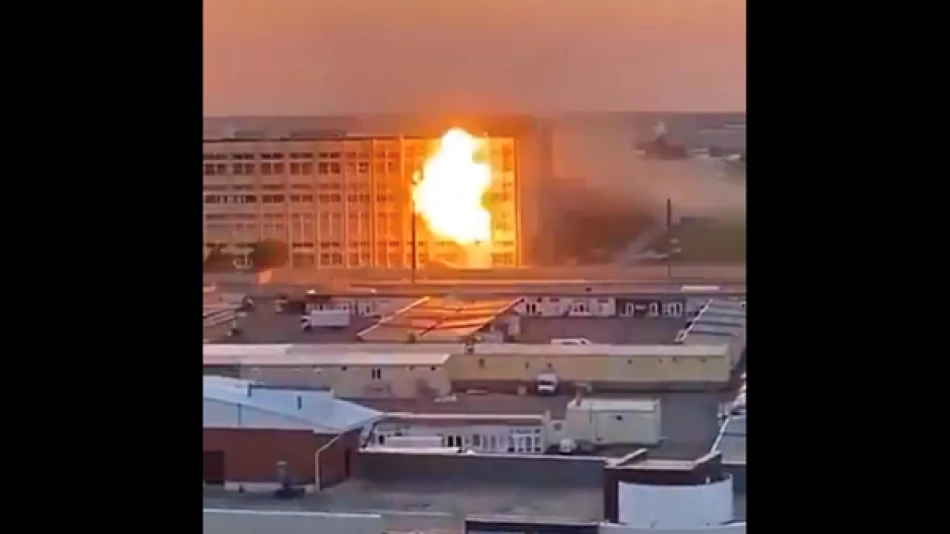
Ukraine Strikes Two Russian Military Facilities, Showcasing Its Defensive Capabilities
Ukraine Strikes Deep Into Russia, Targeting Critical Electronic Warfare Factory
Ukrainian security forces have successfully targeted a major Russian electronic warfare manufacturing facility 540 kilometers from the border, marking another escalation in Kyiv's campaign to disrupt Moscow's military-industrial complex. The overnight drone strike on the Signal factory in Stavropol represents Ukraine's growing capability to project power deep into Russian territory and degrade critical defense infrastructure.
Strategic Target: Disrupting Russia's Electronic Warfare Edge
The Signal factory in Stavropol stands as one of Russia's premier facilities for producing electronic warfare equipment, including radar systems, radio navigation gear, and wireless communication devices. Ukrainian security officials confirmed that two separate facilities within the complex sustained damage from the precision drone attack.
Video footage released by Ukrainian authorities shows massive explosions followed by thick columns of smoke rising into the night sky, suggesting significant structural damage to the production facilities. The choice of target reflects Ukraine's strategic focus on degrading Russia's technological advantages in electronic warfare—capabilities that have proven crucial in modern battlefield communications and air defense systems.
Long-Range Capabilities Signal New Phase
The 540-kilometer range of this attack demonstrates Ukraine's expanding arsenal of long-range strike capabilities, likely involving domestically produced drones that can penetrate deep into Russian airspace. This distance puts previously "safe" Russian military production facilities within Ukrainian reach, forcing Moscow to reconsider the security of its defense industrial base.
Systematic Campaign Against Military Production
Ukrainian officials emphasized that such strikes form part of a broader strategy to systematically degrade Russian military capabilities. "Every such attack stops production operations and reduces Russia's military potential. This work will continue," the security official stated, signaling that similar operations are likely to follow.
This approach mirrors successful Allied bombing campaigns against Axis industrial targets during World War II, where sustained attacks on manufacturing facilities gradually weakened enemy capabilities over time. Ukraine appears to be applying similar principles, targeting the supply chain rather than just frontline forces.
Impact on Russian Defense Industry
Electronic warfare equipment represents a critical component of Russia's military strategy, particularly given Moscow's emphasis on disrupting Ukrainian communications and NATO-supplied precision weapons. The Signal factory's production lines likely support multiple Russian military units across various fronts, making its disruption strategically significant beyond the immediate tactical impact.
Escalation Dynamics and Strategic Implications
The strike raises important questions about escalation dynamics in the conflict. By targeting military-industrial facilities rather than civilian infrastructure, Ukraine maintains a clear military rationale for its operations while avoiding the international condemnation that typically follows attacks on non-military targets.
For Russia, protecting its vast defense industrial complex—much of it located hundreds of kilometers from the Ukrainian border—presents a significant challenge. The country's air defense systems were designed primarily to counter threats from NATO, not sustained drone campaigns from the south.
International Response and Support
While Ukraine has not disclosed the specific technology used in the attack, the operation's success suggests either significant advances in domestic drone production or continued covert support from Western allies. The precision and range demonstrated align with Ukraine's stated goal of achieving strategic parity with Russia despite its smaller industrial base.
The targeting of electronic warfare facilities may also serve Western interests, as Russian electronic warfare capabilities have proven effective against NATO-standard equipment provided to Ukraine. Degrading these capabilities could enhance the effectiveness of Western military aid.
Most Viewed News

 Layla Al Mansoori
Layla Al Mansoori






